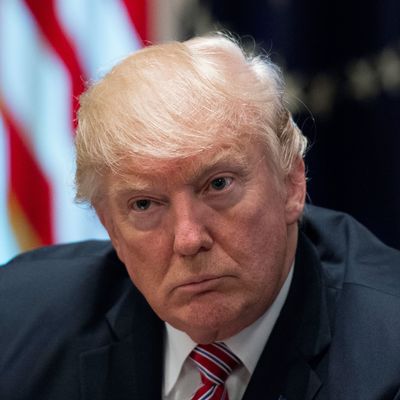
A presidential tweet yesterday afternoon helps us answer a pertinent question: How does Trump justify supporting GOP health plans that violate his pledge during the campaign to oppose cuts in Medicaid spending?
It seems POTUS does not understand how Medicaid funding works, and thus what constitutes a “cut.” He appears to think if any program’s funding goes up year-to-year, it hasn’t been “cut.”
This is rarely true, actually. Even with programs that are subject to annual appropriations, providing the same services from one year to the next usually costs more, thanks to inflation and population growth. Demographic changes and economic circumstances can aggravate or ameliorate the need for more funding. But you cannot point to a rise in funding and say, “That’s not a cut,” without knowing a lot more about the program, its services, and the specific population it serves.
With an entitlement program like Medicaid, moreover, in which defined categories of people receive defined benefits automatically, annual spending increases are virtually guaranteed unless the population is shrinking or the economy is really booming. As it happens, Medicaid spending under current policies is going up significantly in the immediate future thanks to at least three factors: the expansion of eligibility 31 states have elected to pursue under the Affordable Care Act; medical inflation, which generally exceeds consumer inflation; and the rapid growth in the senior population, adding to the number of Medicaid’s most expensive beneficiaries.
You can argue, as many Republicans do, that policy makers should act to curb Medicaid’s rising costs. But you can’t claim such efforts are not “a cut.” For the Medicaid expansion population at greatest risk of losing eligibility entirely under the House and Senate health-care bills, that would definitely represent “a cut.” The same is true of any Medicaid participants who may have to deal with reduced benefits or increased “cost-sharing” requirements as states adjust to a per capita cap on federal Medicaid payments.
Since we will never entirely agree on what the “normal” or “natural” funding levels for a program like Medicaid should be, the only rational way to look at Medicaid proposals is to compare how much money it would take to finance Medicaid under current law, and how much the proposals would change those costs. That is precisely what the Congressional Budget Office — who are not “Democrats,” mind you, but hires of a Republican-controlled Congress — did in describing the Better Care Reconciliation Act as “cutting” Medicaid spending by $772 billion over ten years. That does not mean reducing Medicaid spending by that much on a year-to-year basis. But it does mean that according to CBO’s best estimates BCRA will undershoot by $772 billion what it costs to provide the same Medicaid services to the people now deemed eligible. And that’s a “cut.”
Now it is entirely possible Donald Trump understands all this and is simply hoping readers of his tweets don’t. That was the calculation his friend Newt Gingrich made back in the 1990s when he perpetually insisted in a highly publicized argument with Bill Clinton that the Medicare and Medicaid cuts he was proposing weren’t cuts at all but simply “reductions in the rate of growth.” (Indeed, Gingrich is saying the same thing now, which may be where Trump got the idea.) He did not win that argument with Clinton then, and Trump is not likely to win it now, particularly since congressional Republicans, whether or not they support their party’s health-care plans, are not buying this line. When real, live people lose things they would otherwise have, they have been “cut.” Pretending otherwise represents ignorance at best and cynical demagoguery at worst.






























